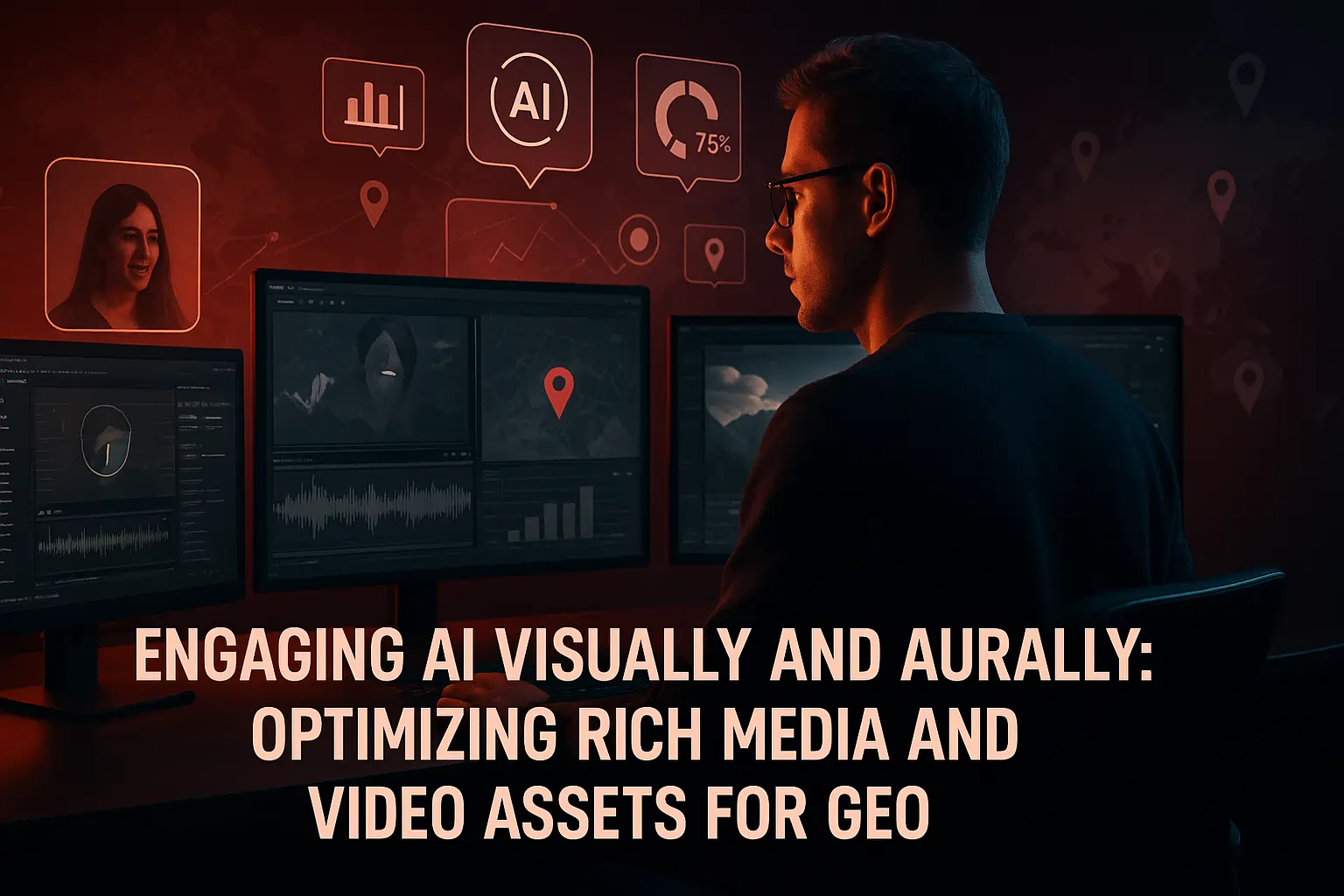Engaging AI Visually and Aurally: Optimizing Rich Media and Video Assets for GEO

Imagine this: a potential customer in your city asks an AI assistant, like Google or ChatGPT, for the "best wedding photographer in Mumbai." The AI instantly shows a beautiful gallery of your competitor's photos and a video testimonial from a happy client. Your business, despite maintaining a great website, isn't mentioned at all. You've just lost a customer without even knowing it.
Why did this happen? The answer lies in a powerful new evolution of digital marketing called Generative Engine Optimization, or GEO.
The way customers find information is changing dramatically. They are no longer just typing keywords into a search bar. They are having conversations with AI, asking complex questions, and expecting direct answers. If your business isn't prepared for this shift, you risk becoming invisible. This guide, from the experts at Public Media Solution, will explain in simple terms what GEO is and give you a practical action plan to make sure your brand’s images and videos are seen and heard in this new AI-powered world.
What is GEO? And Why It’s Not Just ‘New SEO’
For years, we’ve all focused on Search Engine Optimization (SEO). The main goal of SEO has been to get your website to the top of Google’s search results to earn a click from a user.
Generative Engine Optimization (GEO) has a different, more ambitious goal. GEO is the art and science of making your content the expert source that AI trusts and chooses to quote in its answers. The new goal isn’t to get a click; it’s to have your brand’s information, photos, or video clips directly featured inside the AI’s response.
Think of it this way: SEO gets you a spot on the library shelf. GEO makes you the expert librarian that everyone asks for advice.
It's important to understand that GEO doesn't replace SEO. In fact, a strong SEO foundation is often necessary for GEO to work. AI models usually look at top-ranking search results first when gathering information. GEO is the next essential chapter, building on what we already know about SEO.
Here’s a simple breakdown of the key differences:
| Feature | Traditional SEO | Generative Engine Optimization (GEO) |
|---|---|---|
| Main Goal | Get a user to click a link on a search results page. | Become the cited source within an AI-generated answer. |
| Content Focus | Keywords, backlinks, and ranking high on a results page. | Factual accuracy, clear structure, and conversational language. |
| Success Metric | Website traffic, keyword rankings, click-through rate (CTR). | Brand mentions, citation frequency, and visibility in AI answers. |
This shift is happening because the modern customer journey is no longer a straight line. A single search for information might involve a Google query, watching a TikTok video, reading a Reddit discussion, and then asking an AI chatbot for a summary. Your business needs to be present and optimized at every one of these steps.
How AI ‘Thinks’ About Your Pictures and Videos
To win at GEO, you first need to understand that AI doesn't see or hear the way we do. An AI is a brilliant but very literal system that processes data. Giving it the proper context is everything.
How AI ‘Sees’ Images
An AI doesn't see a photo of a delicious plate of biryani the way we do. It sees a complex pattern of pixels and shapes. It’s the ‘masala’ of metadata—the descriptive words you put around the image that tells the AI that this is a signature dish from your acclaimed restaurant. Without that context, it's just a meaningless collection of data. The AI relies heavily on things like the image's filename, the text around it on the page, and special tags to understand what the picture is about.
How AI ‘Hears’ Audio and ‘Watches’ Video
Similarly, an AI processes audio not as speech or music, but as a soundwave. For a video, it analyzes a sequence of image frames and the accompanying audio track.
The single most powerful tool you can give an AI to understand your video or audio content is a transcript. A complete, accurate transcript turns your spoken words into a searchable, indexable text that the AI can read and understand perfectly. This allows an AI to find the exact 15-second clip where you answer a critical customer question, making your video the perfect source for an answer.
Your Action Plan: 5 Steps to Make Your Media AI-Friendly
Now for the practical part. Here are five straightforward steps you can take to optimize your rich media for GEO.
1. Give Your Images a Clear ‘Name Tag’ (Filenames and Alt Text)
This is the most basic but crucial step. Never use default filenames from your camera. Instead, give your images descriptive, keyword-rich names.
- Before: IMG_2025.jpg
- After: handmade-leather-shoes-kolkata
Equally important is "alt text." This is a short, written description of an image that you add to your website's code. It helps visually impaired users and gives AI a clear description of what the photo shows.
- Good Alt Text: "A skilled artisan in Kolkata hand-stitching a pair of brown leather formal shoes."
2. Turn Your Videos into a ‘Book’ for AI to Read (Transcripts)
As mentioned, transcripts are a game-changer for video and audio GEO. Always include a complete, proper transcript on the same page as your video or podcast player. This makes every word you say completely accessible to AI engines, allowing them to pull out specific quotes and answers. This simple step can dramatically increase the chances of your video content being used as a source in an AI response.
3. Become the Trusted ‘Expert’ in Your Field (E-E-A-T)
AI models are designed to find and promote content that demonstrates Experience, Expertise, Authoritativeness, and Trust (E-E-A-T). You need to prove to both your customers and the AI that you are a credible expert.
- Showcase Experience: Share detailed case studies and real-world examples.
- Prove Expertise: Have industry experts write or review your content. Add author bios and credentials.
- Build Authority: Get mentioned in respected industry publications and engage in relevant online forums like Reddit and Quora, as AI often trusts these honest user conversations.
- Establish Trust: Display customer testimonials, reviews, and precise contact information.
4. Structure Your Content Like a Q&A Session (FAQs and Lists)
AI loves well-structured content because it’s easy to parse and extract information from. Just like a busy human reader, an AI can quickly scan and understand content that is neatly organized.
- Use clear headings and subheadings (H1, H2, H3) to create a logical hierarchy.
- Use bullet points and numbered lists to break down information.
- Create dedicated FAQ sections on your pages to directly answer common customer questions. This makes it incredibly easy for an AI to grab your answer and use it.
5. Use the ‘Secret Language’ of AI (Schema Markup)
This might sound technical, but the concept is simple. Schema markup is a piece of code you add to your website to give search engines more context about your content. Think of it as a special 'digital label' you put on your content so AI knows precisely what it is.
For example, you can use schema to tell an AI:
- "This is a how-to guide with 5 steps" (HowTo schema).
- "This is a video about SEO" (VideoObject schema).
- "This is a list of frequently asked questions" (FAQPage schema).
Implementing schema makes your content much easier for AI to understand and categorize, significantly increasing your chances of being featured in rich, detailed AI answers.
The Future is Visual and Vocal: Are You Ready?
The shift to an AI-first search world is not a distant future, it's happening right now. Clicks and website visits are becoming less critical, while brand mentions and citations within AI answers are the new currency of success. By optimizing your images, videos, and audio content, you are not just keeping up with a trend; you are future-proofing your business.
The key takeaways are simple:
- Aim to be the answer, not just a link.
- Provide clear context for all your media with descriptive metadata.
- Structure your content so it’s easy for both humans and AI to understand.
Navigating the AI search revolution can feel complex, but you don't have to do it alone. The team of digital specialists at Public Media Solution specializes in building powerful GEO strategies that ensure your brand is not just seen, but heard and cited in this new digital landscape. As a one-stop solution for PR, Branding, and Digital Marketing, we craft compelling narratives that ensure your messages reach far and wide in the new AI-powered world.
Share
Table Of Contents
- What is GEO? And Why It’s Not Just ‘New SEO’
- How AI ‘Thinks’ About Your Pictures and Videos
- Your Action Plan: 5 Steps to Make Your Media AI-Friendly
- The Future is Visual and Vocal: Are You Ready?
